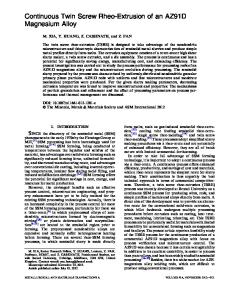Study on Pressurized Solidification Behavior and Microstructure Characteristics of Squeeze Casting Magnesium Alloy AZ91D
- PDF / 2,139,731 Bytes
- 9 Pages / 593.972 x 792 pts Page_size
- 60 Downloads / 364 Views
TION
MAGNESIUM is an important structural material for lightweighting in automobile applications because of its lower density (compared with aluminum or steels), excellent castability and machinability as is reported by Sachdeva et al.[1] However, Masoumi and Hu[2] pointed out that to date, the applications of magnesium alloys in automobiles such as instrument panel beams, steering wheels, and seat frames have been mostly limited to the die cast parts. High-pressure die-casting (HPDC) is a wellestablished manufacturing process due to its high efficiency and low cost. Nevertheless, porosity is a major defect in HPDC due to air entrapment caused by turbulent die filling or solidification shrinkage in the casting process according to Dahle et al.[3] Wang et al.[4] reported that such porosity deteriorates mechanical properties limiting the applications to components that are not highly stressed and also does not allow any ZHIQIANG HAN, Associate Professor, and HAOWEI PAN, Postgraduate Student, are with the Key Laboratory for Advanced Materials Processing Technology, Ministry of Education, School of Materials Science and Engineering, Tsinghua University, Beijing 100084, P.R. China. Contact e-mail: [email protected] YANDA LI, formerly Postgraduate Student with the Key Laboratory for Advanced Materials Processing Technology, Ministry of Education, School of Materials Science and Engineering, Tsinghua University, is now Assistant Engineer with the Airworthiness Management Department, Shanghai Aircraft Manufacturing Co., Ltd., Shanghai 200436, P.R. China. ALAN A. LUO, Professor, is with the College of Engineering, The Ohio State University, Columbus, OH 43210. ANIL K. SACHDEV, Lab Group Manager, is with the Chemical and Materials Systems Laboratory, General Motors Global Research and Development Center, Warren, MI 48090. Manuscript submitted October 22, 2013. Article published online October 21, 2014. 328—VOLUME 46B, FEBRUARY 2015
subsequent heat treatment that could lead to an increase in strength. High vacuum die-casting, which is an effective technique to avoid air entrapment by evacuating the die cavity before casting, has been receiving attention.[5] However, the porosity caused by solidification shrinkage is still difficult to reduce. One of the promising techniques capable of producing high integrity components is squeeze casting. Squeeze casting offers the advantages of (a) non-turbulent die filling, which means essentially no air entrapment (b) solidifying under an external pressure introduces plastic deformation that compensates for volume shrinkage, and (c) thick-walled magnesium parts produced by squeeze casting can be subjected to heat treatment for enhancing mechanical properties. Some research on squeeze casting magnesium alloys has been reported in the literature. Yue et al.[6] studied the effect of grain size on mechanical properties of squeeze casting magnesium alloy AZ91. Masoumi and Hu[2] investigated the influence of applied pressure on microstructure and tensile properties of squeeze cast magnesium alloy. Klei
Data Loading...











